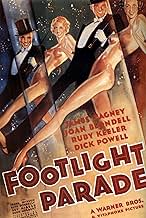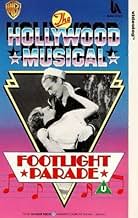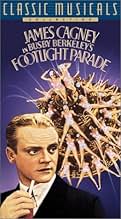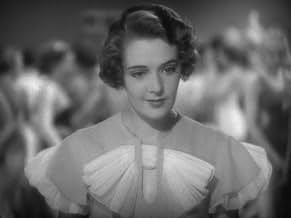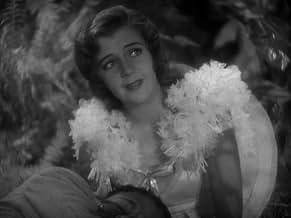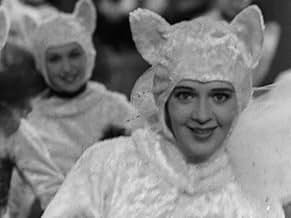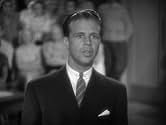Chester Kent lucha contra el tiempo, el romance y el espía de un rival para producir espectaculares "prólogos" en directo para salas de cine.Chester Kent lucha contra el tiempo, el romance y el espía de un rival para producir espectaculares "prólogos" en directo para salas de cine.Chester Kent lucha contra el tiempo, el romance y el espía de un rival para producir espectaculares "prólogos" en directo para salas de cine.
- Dirección
- Guionistas
- Elenco
- Premios
- 3 premios ganados en total
- Chorus Girl
- (sin créditos)
- Chorus Girl
- (sin créditos)
Opiniones destacadas
Sure, Warner Bros. tries to cover the orgy with the fig leaf of two cheerful innocents played by a sappy Dick Powell and a virginal Ruby Keeler. But it doesn't work, because everyone else gets in on the fun, including that human buzz-saw Jimmy Cagney and everyone's favorite sassy dame Joan Blondell. Director Lloyd Bacon proves too he knows what to do, giving us an eyeful of Blondell endlessly rolling and unrolling her hosiery, while the writers pepper the conversation with suggestive one-liners. Yeah, it's a great movie-- good enough to help bring down the heavy hand of censorship the following year, and put an end to damp dreams like "Beside a Waterfall". But not even the Watchdogs of Public Morality could stop Berkeley's deliriously suggestive pageantry that would live on at even that most repressed of studios, MGM. Sure, Astaire-Rogers may have been more graceful and a whole lot more chaste, no doubt producing more sheer polish-- still and all, don't let this unabashedly pagan celebration pass you by. As they say around the owl cage, it's a real hoot.
Watching it again tonight, I was, however, struck yet once again by the genius of Busby Berkeley in staging the last three numbers, the "prologues." Most remarkable of a very remarkable trio for me is "Beside a waterfall." It just keeps building and building and building. Yes, of course, some of the shots of the women in the water are very erotic. It was 1933, after all, and before the Hayes Code. Berkeley and Warner Brothers understood that pretty women posed erotically had a real appeal to men,
------------------------------------
I watched the end of this movie again this morning. Perhaps I paid closer attention to this number this time, perhaps I was just in the right "mood." Either way, I marveled at the suggestiveness of so much of it. Those jets of water spurting up - I use the verb advisedly - between the swimming women's legs. All those shots of women opening and closing their legs. It was remarkably erotic on my 46" tv screen. What must it have been like in 1933 on huge movie theater screens in the era before multiplexes????
==========================================
But these erotic poses are not JUST erotic poses. The number keeps building and building and building. What will he do next, you keep wondering? Oh, that. But "that" is even more incredible than what has come before. By the time you get to the end of this number, you're exhausted, not just physically and erotically, but imaginatively as well. How could anyone have maintained and built on that suspense for 10 whole minutes? I can't tell you, but Berkeley did.
Third of the three prologues, "Shanghai Lil," is definitely not something that could have been filmed the same way just a year or two later when the Production Code was put in force. We see an opium den, a lot of prostitutes, at least one interracial couple, etc.
Having watched it again tonight, I will add that this is a strange "musical." There is almost no music for the first hour and a half. It's all in the three closing numbers. But what numbers!
Busby, of course, is the undisputed master of the Hollywood musical with "Gold Diggers of 1933" and "42nd Street" to his credit (as Dance Director). Footlight Parade is graced by hundreds of scantily-clad chorus girls, a Berkeley trademark. The elaborate dance numbers were shot with only one camera and Busby was the first director to film close-ups of the dancers. His obsession with shapely legs and "rear-view" shots is amply demonstrated here. The overall effect is highly erotic and mesmerizing.
Our boy Jimmy Cagney plays Chester Kent, a producer of "prologues" or short musical stage productions that were performed in movie theaters to entertain the audience before the talkies were shown. He's surrounded by crooked partners, a corporate spy, and a gold-digging girlfriend. Although Cagney had a solid background in vaudeville, this was the first film in which he showed his dancing talents. Joan Blondell is memorable as Cagney's wise-cracking, lovestruck secretary. And Ruby Keeler is adorable, as always.
The film climaxes with three outstanding production numbers, "Honeymoon Hotel", "The Waterfall", and "Shanghai Lil", each one a masterpiece and not likely to be duplicated in today's Hollywood where so-called "special effects" have replaced creative cinematography.
Claudia's Bottom Line: Clever and erotic, with some of the best musical production numbers ever put on celluloid. A thoroughly enjoyable Depression era romp.
The realistic, satirical treatment gives a fresh edge to the material and its pace and line delivery are breathtaking. To think that they only started making feature talking pictures 7 years before this! The brilliance of the dialogue cannot be matched anywhere today, especially considering that "realism" has taken over and engulfed contemporary cinema.
This film was made at a time when the Hayes code restricting content was being ignored and the result is a fresh, self-referential, critical and living cinema that spoke directly to contemporary audiences suffering through the depression and the general angst of the age. I'd recommend watching any film from this period, that is 1930-1935, for a vision of what popular cinema can potentially be.
¿Sabías que…?
- TriviaFirst film where James Cagney dances - showing off his vaudeville and stage experience as a song-and-dance man. Cagney lobbied Warner Bros. to play this role. He would show off these talents to their fullest in El canto de la victoria (1942).
- ErroresAfter the "By A Waterfall" prologue ends, the film cuts to the audience giving an animated and thunderous applause, but in the balcony there is no applause or reaction. In fact, there is no movement whatsoever. They are perfectly still which indicates that a photo or painting was used for the balcony audience and then merged with the live theatre audience. The same photo/painting was also used for the "Shanghai Lil" balcony audience.
- Citas
Nan Prescott: You scram, before I wrap a chair around your neck!
Vivian Rich: [Angrily] It's three o'clock in the morning - where do you want me to go?
[Nan starts to speak, but Vivian immediately cuts her off]
Vivian Rich: You cheap stenographer...
Nan Prescott: Outside, countess. As long as they've got sidewalks YOU'VE got a job.
[Shoves her out, gives her a swift kick in the rump, and slams the door behind her]
- Versiones alternativasThere is an Italian edition of this film on DVD, distributed by DNA srl, "VIVA LE DONNE! (1933) + AMORE IN OTTO LEZIONI (1936)" (2 Films on a single DVD), re-edited with the contribution of film historian Riccardo Cusin. This version is also available for streaming on some platforms.
- ConexionesEdited into Busby Berkeley and the Gold Diggers (1969)
- Bandas sonorasA Vision of Salome
(1908) (uncredited)
Music by J. Bodewalt Lampe
Played during the prologue scene in the movie theater
Selecciones populares
- How long is Footlight Parade?Con tecnología de Alexa
Detalles
Taquilla
- Presupuesto
- USD 703,000 (estimado)
- Total a nivel mundial
- USD 276
- Tiempo de ejecución
- 1h 44min(104 min)
- Color
- Relación de aspecto
- 1.37 : 1



